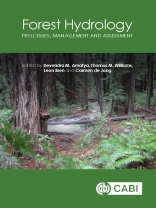Forests cover approximately 26% of the world’s land surface area and represent a distinct biotic community. They interact with water and soil in a variety of ways, providing canopy surfaces which trap precipitation and allow evaporation back into the atmosphere, thus regulating how much water reaches the forest floor as through fall, as well as pull water from the soil for transpiration.
The discipline ‘forest hydrology’ has been developed throughout the 20th century. During that time human intervention in natural landscapes has increased, and land use and management practices have intensified. This book:
– Presents cutting edge thinking and assessments in forest hydrology across all latitudes and terrains, including state-of-the-art modelling techniques and methodologies
– Describes the latest challenges facing forest hydrology, such as increased occurrence of disturbance, due to extreme floods, drought, disease, and fire, potentially caused by climate change
– Is written by an internationally renowned team of scientists, engineers, and managers to give a well-rounded review of the subject
The book will be useful for graduate students, professionals, land managers, practitioners, and researchers with a good understanding of the basic principles of hydrology and hydrologic processes.
Sobre o autor
Dr. Carmen de Jong is Full Professor at the University of Strasbourg in Strasbourg, France. Her basic training is in Hydrology and Geomorphology. She earned a Ph D in fluvial geomorphology of mountain streams in the USA and Germany from the Free University of Berlin and a habilitation in floods and droughts in the High Atlas and Alps from the University of Bonn, Germany. She works on climate change and anthropogenic impacts on hydrology of forested catchments in the Black Forest and Palatinate Forest in Germany and Vosges in France.












